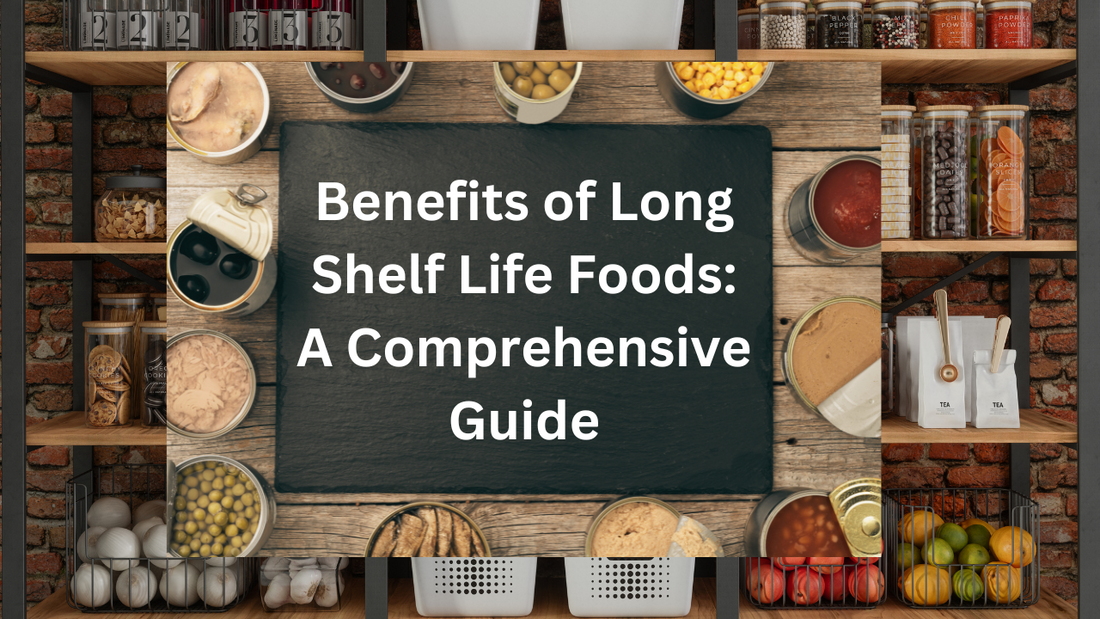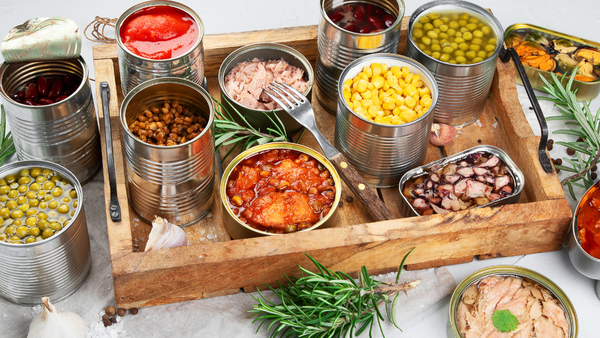The foods we eat go through many stages before they reach our table. One of these stages is storage. It can occur at different stages: in production, in storage facilities, in warehouses and even in our homes. Storing food helps maintain its freshness, flavor, and nutritional value.
However, storing for too long can have a negative impact on the products. During storage, not only the taste of products can change, but also their composition. In some cases, this can lead to the emergence of harmful substances and microorganisms.
Therefore, it is important to know how long a particular product can be stored in order to avoid loss of its nutritional properties and, most importantly, not harm your health. In this article we will look at which foods are affected by Long Shelf-Life Foods and what can be done to maintain their freshness and nutrition.
What is long-term food storage?
Long-term food storage is the process of preserving food products longer than they can maintain their freshness and quality at room temperature. For long-term storage of products, it is necessary to create unique conditions, such as low temperature, a certain level of humidity and vacuum packaging.
Most foods cannot be kept fresh and safe for consumption for long periods of time. But there are some foods that can be stored longer than others, such as frozen vegetables, dry foods, canned foods, and others.
The purpose of Long Shelf-Life Foods is to maintain the quality and safety of the product, as well as to extend the life cycle of the product to improve its economic value. However, long-term storage can reduce the quality of the product and, in some cases, lose its nutritional value.
Types of Foods That Last 25 Years
-
Frozen food
-
Dry products
-
Canned foods or MRE
-
Semi-finished products
In order for the product to maintain its freshness and safety for a long time, it is necessary to comply with the storage conditions indicated on the packaging. There are also foods that are not intended for long-term storage and should be consumed within a few days after purchase or preparation. For example, fresh vegetables and fruits, dairy products.
It is important to understand that long-term storage may vary in duration depending on storage conditions and methods, as well as the product. Therefore, you should not abuse long-term storage of products and always monitor their quality and expiration dates.
What are the benefits of long shelf life food?
Economic benefits. Products are stored for a long time to reduce costs and save on production. When food is stored for a long time, it helps to increase food inventory and reduce the quantity of food produced.
Extending shelf life. To ensure that products can be stored for a long time, they are processed in various ways. For example, products are canned, dried, frozen, processed into powder, etc. As a result, the shelf life of the product is extended.
Convenience of consumers. long-lasting foods are also cost-effective. By purchasing foods with an extended shelf life, you can take advantage of bulk discounts and avoid frequent trips to the supermarket. These foods allow you to plan your meals, reducing the chances of food waste and saving money in the long run.
Increased availability of products. Long-term food storage allows products to be distributed over long distances. Products can be shipped from one region to another without the risk of food spoilage.
How does long-term storage affect food quality?
Long-term storage of products can lead to changes in their quality. One of the main factors is fat oxidation. During long-term storage, fats oxidize and become rancid, which is why the product may have an unpleasant odor and taste. Fish, meat and nuts are most susceptible to oxidative processes.
Also, long-term storage can lead to the accumulation of bacteria in the product. This is especially true for dairy products, fruits and vegetables. Improper storage of thermally processed products can lead to the growth of pathogens and increased toxicity of the product. Before use, you should carefully check the product for cracks, stains and mold.
Some products, such as wine, can improve their taste when stored for a long time. However, such products must be stored under special conditions and at properly selected temperature conditions.
In addition, long-term storage can lead to loss of vitamins and minerals in products. Fresh fruits and vegetables contain more vitamins, so to preserve their beneficial properties, it is necessary to store foods properly, avoiding direct sunlight and high temperatures.
To maintain product quality, it is necessary to carefully monitor expiration dates, choose the right storage conditions and periodically check products for compliance with quality standards. Only in this case can you be sure of the safety and usefulness of the products you consume.
Which products are most often subject to long-term storage?
Some products can be stored for a long time without spoiling their taste and nutritional qualities. However, this requires certain storage and preservation conditions.
Below is a list of products that are most often subject to long-term storage:

2. Dehydrated or Freeze-Dried Food: Frozen vegetables, fruits, meat and fish retain their nutritional and vitamin properties for several months if they are stored at a certain temperature in the freezer. But keep in mind that freezing may cause some foods to lose their texture and flavor.
3. Dried fruits: Dried fruits such as dried apricots, raisins and apricots have a long shelf life and can retain their nutritional value for up to a year if stored in a cool, dry place. They are also convenient in that they can be used for making desserts and baking.
4. Cereals: Packaged grains such as buckwheat, rice, millet and many others can be stored in a cool, dry place for up to a year.
5. Spices and Seasonings: Dried herbs and spices can be stored in tightly sealed jars in a cool place for up to several years. However, with age they can lose their aroma and taste and should be changed periodically.
6.MRE (Meals Ready-to-Eat)

Buy: MRE Meals
MREs, or Meals Ready-to-Eat, are self-contained, individual food rations designed for the U.S. military in field situations. They provide around 1,200 calories per meal and boast a long shelf life (around 3 years) for convenient storage and transport.
It is important to understand that all products have a specific expiration date, and consuming them after the expiration date can be hazardous to health. Therefore, when purchasing and storing products, you must follow the recommendations for their storage and use.
How to properly store foods with a long shelf life
There are several rules that can help keep foods with a long shelf life safe and prevent them from spoiling. Here are some of them:
-
Store food in a cool and dry place. The ideal temperature is between 50 and 70 degrees Fahrenheit (10 to 21 degrees Celsius). Also, humidity levels should be around 15% to 20% to ensure optimal storage conditions, avoid exposure to direct sunlight and places where the temperature may vary (for example, near stove).
-
Do not defrost food or refreeze it. Thawed foods should be consumed as soon as possible and should not be re-frozen.
-
Store food in airtight containers. This will help prevent air and bacteria from getting into the product, which could cause it to spoil.
-
Do not store food near chemicals such as detergents or solvents. This may contaminate food with chemicals and make it unfit for consumption.
-
Do not store foods with a long shelf life near foods that spoil quickly. This can lead to contamination of perishable foods with bacteria from foods with a long shelf life.
Recommended Food Storage Times
NR= Not Recommended

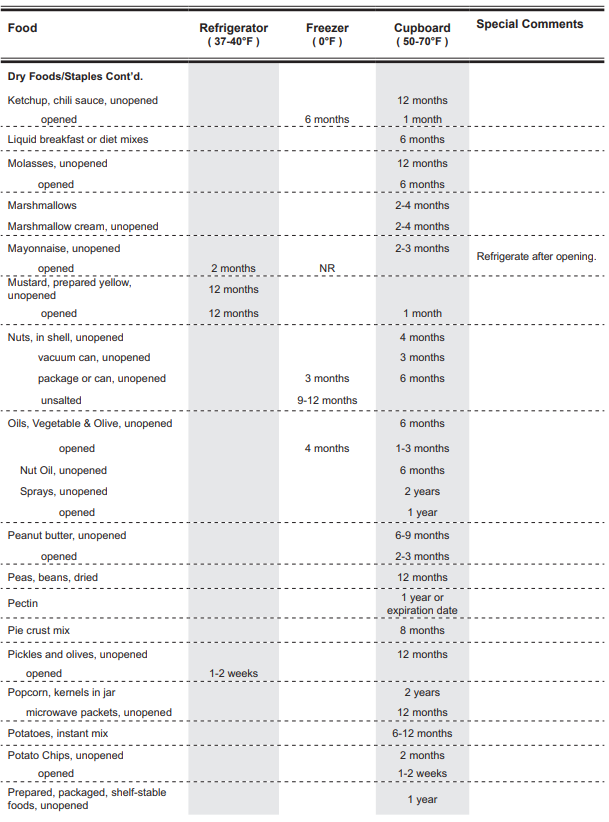
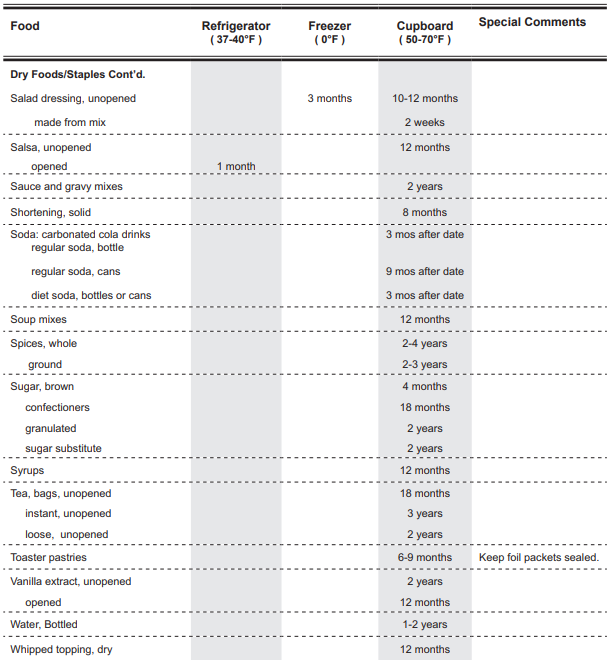
Source: https://nchfp.uga.edu/how/store/UGA_foodstorage_2011.pdf
Following these guidelines will help keep foods with a long shelf life fresh and safe to eat.
Nutritional Value:
1. Retention of Vitamins and Minerals
One may wonder if they can still provide the necessary vitamins and minerals for a healthy diet. The good news is that many options for long term foods retain a significant amount of these essential nutrients.
2. Balanced Macronutrients
In addition to vitamins and minerals, long-lasting foods balance macronutrients, including carbohydrates, proteins, and fats, essential for a healthy diet.
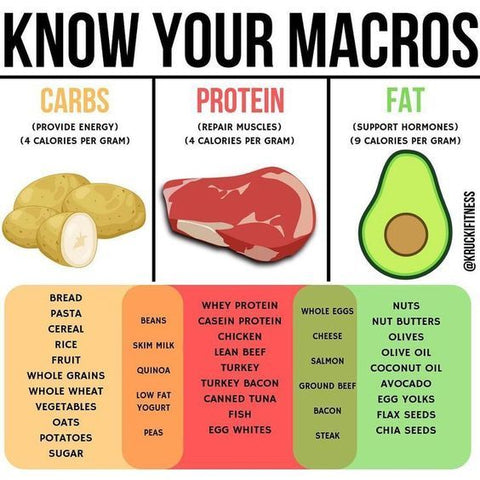
Source: https://in.pinterest.com/pin/43347215158635110/
-
Carbohydrates: Include a variety of carbohydrate sources such as grains, legumes, and starchy vegetables. These carbohydrates provide energy and are an essential part of a balanced diet.
-
Proteins: Protein is crucial for maintaining and repairing body tissues. Long-lasting food options such as canned meats, freeze-dried meats, and legumes offer valuable protein sources.
-
Fats: While it's important to consume fats in moderation, they are still essential to a balanced diet. often include healthy fats such as nuts, seeds, and oils, which provide energy and support various bodily functions.
3. Dietary Fiber Content
Dietary fibre is another vital component of a healthy diet, as it aids digestion and promotes overall gut health. shelf stable foods can also contribute to your daily fibre intake.
Are foods with a long shelf life harmful?
Many people believe that foods with a long shelf life are harmful to the body. However, this is not always the case. In fact, the expiration date is only the maximum period during which a product can maintain its quality properties and safety for consumption.
If the product has been properly stored and its integrity has not been compromised, then it may be safe for consumption even after the expiration date. However, such a product may lose its freshness, taste and aroma.
It should also be taken into account that some foods may have a long shelf life due to preservation or processing, which in turn may have a negative impact on their nutritional value. Therefore, it is important to read the ingredients and choose products with minimal preservatives and artificial additives.
Thus, you should not consider all products with a long shelf life to be harmful. The main thing is to store them correctly and consume them in moderation, following the manufacturers' recommendations.
How to choose foods with a long shelf life?

Here are some tips to help you make the right choice:
-
Avoid products with too short a shelf life. The longer a product can retain its properties, the better suited it is for long-term storage.
-
Choose foods that are low in moisture. Water is the factor that stimulates the development of bacteria and mold. Therefore, foods with high moisture content are prone to spoilage.
-
Choose foods that can be frozen. Many foods can be stored frozen for several months. At the same time, the quality of the product is maintained longer.
-
Study the product packaging. Some products are packaged in special pouches or vacuum packaging. This significantly increases the shelf life of the product.
-
Consider the food storage temperature. Some foods store best at low temperatures, others at room temperature. Study the manufacturer's recommendations and try to follow all recommendations for storing the product.
It is important to remember that long-term storage may reduce the nutritional value of the product. Therefore, when stocking up, try to choose products that will retain their properties as close to their original state as possible.
FAQs
-
How does long-term storage of food affect its nutritional value?
Long-term storage can result in loss of vitamins and other nutrients, especially if food is stored at elevated temperatures or in high humidity conditions. This can lead to a decrease in protein, carbonates and other important components in foods.
-
What foods store best in the refrigerator?
Raw meats, dairy products, eggs, fruits and vegetables are best stored in the refrigerator. However, some fruits and vegetables may lose their freshness and flavor at low temperatures, so you should carefully study the storage instructions for each product.
-
Is it possible to preserve food without refrigeration?
Yes, you can. Some foods, such as dry legumes, nuts and rice, can be stored without refrigeration if they are stored in a cool, dry place. However, if you are storing meat, dairy or eggs, you must use a refrigerator to avoid the development of bacteria.
-
Which foods have the longest shelf life and how long can they be stored?
Some of the foods with the longest shelf life include dry beans and rice. They can be stored for up to 25 years. Other products include grains, oils, honey, soy sauce and some types of cheese. However, even such products can lose their properties and become unfit for consumption if they are not stored according to the instructions on the packaging.


